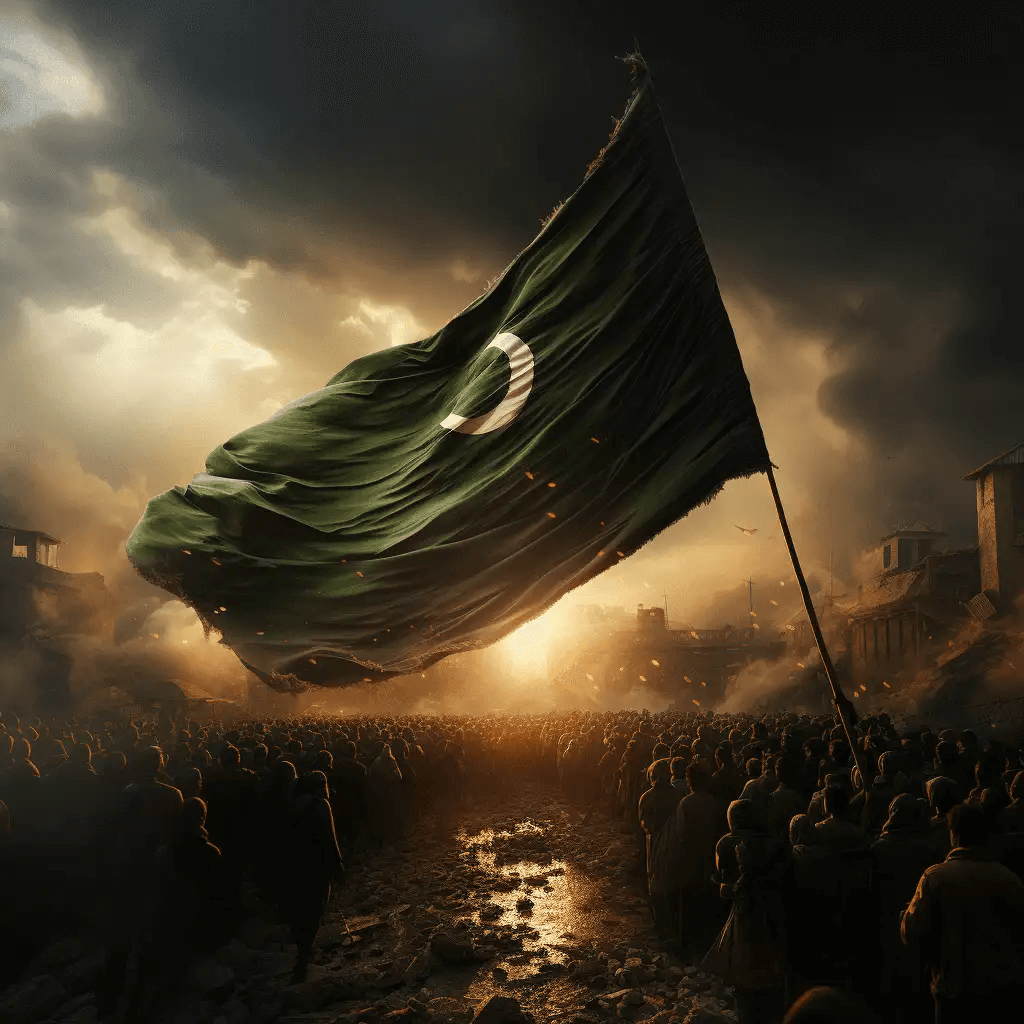Pakistan at Tipping Point
Today, I’ll discuss the political situation in Pakistan. Last year, a democratically elected government was ousted by the Pakistani military. Following this, the opposition party assumed power, and now an interim or caretaker government is in place. Behind the scenes, the real influence shaping this caretaker government is the military.
Historical Perspective
To understand the geopolitics of any region, or the economic system of any country, a historical perspective is essential. It takes generations for a nation to establish its institutions and mold the mindset of its citizens. Rapid transformation is rare. Multiple forces influence a country’s trajectory.
Pakistan was established in 1947 after gaining independence from Great Britain, alongside India. Originally, Pakistan consisted of two regions: East and West Pakistan. However, East Pakistan eventually became its own nation, Bangladesh. Present-day Pakistan was formerly West Pakistan.
Throughout its 76-year history, Pakistan has often been under military rule, either directly or indirectly. While many compare Pakistan’s situation with Western countries, it’s an unfair comparison. For instance, the United States has spent almost 250 years refining its institutions and systems, while Pakistan has had only 76 years.
Additionally, the starting points of these nations were distinct. The British initially entered the Indian subcontinent from the south, introducing modern technology, institutions, scientific thinking, and Western concepts of liberty, justice, and freedom. In contrast, Northern regions, including present-day Pakistan, interacted primarily with Central Asian powers that didn’t bring the same level of technological and scientific advancement.
The British established large military garrisons in the north, especially around Rawalpindi, to counter local resistances. This military infrastructure persisted after independence. Consequently, Pakistan inherited a significant military apparatus but lagged in technological and liberal thought development.
In essence, the challenges Pakistan faces today are deeply rooted in its history. A significant military infrastructure, combined with comparatively lesser technological and liberal progress, has shaped its current political landscape.
Three distinct phenomena have shaped Pakistan’s development:
Late Start
Compared to its neighbor, India, Pakistan began its developmental journey slightly later. This delay can be attributed to the British introducing modern technology, institutions, and scientific thinking to India first, as their invasion began from the south. The remnants of colonial rule had disparate impacts across regions. While India boasted certain areas that flourished as epicenters of education and technological advancement during the colonial era, the territories that later formed Pakistan lagged in these sectors. Consequently, in the post-independence era, Pakistan faced specific deficits in crucial areas, impacting its trajectory toward becoming a modern nation.
Military-Industrial Complex
Pakistan inherited a disproportionately large military apparatus relative to its population.
Feudalism
Unlike India, where feudalism was curtailed post-independence, in Pakistan, the feudal elites continued to dominate. Land reforms were limited, mostly to the KPK province. In many parts of Pakistan, especially Punjab, such reforms never occurred. Consequently, even today, a few landowners possess vast tracts of land, maintaining feudalism’s influence.
In Pakistan’s early years, these feudal elites lived opulent lifestyles, controlling political dynamics, institutions, and even the constitution. Observing this, the military thought, “Why not join them?” and began interfering in politics and other domains. The military extended its influence into sectors and businesses uncommon for armed forces in Western nations.
To legitimize their expanding role, the military employed two strategies:
Narrative of External Threat
They promoted a narrative emphasizing Pakistan’s vulnerability, particularly from India. The Kashmir dispute, a longstanding contention between the two nations, was showcased as proof of this imminent threat. This narrative was effective in justifying the military’s outsized role in governance.
Religion as Control
Given Pakistan’s educational disparity and its lag in technological advancements, the military realized that religion could be a potent tool for control. This led to an emphasis on Islamic teachings in education, often at the expense of scientific and technological subjects.
In summary, a blend of historical factors, combined with the strategic choices of powerful institutions, has profoundly influenced Pakistan’s trajectory.
Much like Britain’s “divide and rule” philosophy, the Pakistani army fostered diverse religious groups to further their goals. They believed that a single dominant religious group could potentially usurp power, so they indirectly (or sometimes directly) supported and funded various religious factions to maintain control.
While Islam was the predominant religion in Pakistan, with Sunni Muslims as the majority and Shias in the minority, divisions were intentionally accentuated. In addition to Sunnis and Shias, subsects such as Sufis, Deobandis, Ahle Hadith (Salafis) and Barelvi, were highlighted, with some, like the Ahmadiyyas, declared non-Muslims by the state — a controversial act given it’s not the state’s role to define religious identity.
Within these broader groups, several subsects were identified or encouraged, such as within Sufism where different orders like Qadiriyya, Chishtiyya, Naqshbandiyya, and others existed. This led to a complex mosaic of religious identities in Pakistan, from Sunnis to Shia subsects like the Twelvers and Ismailis.
From a strategic perspective, this diversity was advantageous. If the army couldn’t control one group or its leader, there were numerous others to work with. The methods of control varied. Financial incentives were the primary tool. Leaders were identified, financially supported, and promoted if they furthered the army’s agenda. In addition to financial support, they received logistical help from the entire bureaucratic machinery.
If financial inducements failed, blackmail was the next tactic. Many of these religious leaders, who weren’t intellectually refined or inherently compromised, could easily be blackmailed with evidence of their wrongdoings. If blackmail didn’t work, intimidation was employed, varying in severity. And as a last resort, uncooperative leaders faced the threat of assassination.
You’ll find that when one individual rises in prominence, another is waiting to be promoted to leadership. Remarkably, the religious machinery of Pakistan is influenced by about 20 to 30 religious leaders, most of whom are believed to be controlled by the army. These leaders, essentially, allow the army to indirectly manage the country.
Concurrently, the elites and feudal lords, particularly in Punjab and other provinces where land reforms didn’t materialize, have garnered much of their wealth through dubious means and corruption. This compromised state makes them vulnerable to manipulation. As the saying goes in Pakistan, the army has information or “files” on these individuals, keeping them in line. If they deviate from the prescribed path, consequences ensue.
The principle is simple: it’s easier to control someone when you’re aware of their wrongdoings. This applies not just to individuals, but to entire nations. It’s often easier to manipulate a dictator, known for questionable ethics, than a just and transparent leader. When there’s no dirt on someone, how can you possibly leverage them?
Even the so-called liberals in Pakistan are not immune. Living in a society marked by regressive thinking inevitably affects one’s worldview. Even if you’re a well-informed intellectual with progressive beliefs, your opinions are still shaped by the immediate environment. Over time, one’s ideals may waver, influenced by societal norms.
On the rare occasion that a truly independent voice emerges, there are methods in place to stifle it, often by force. This strategy of control and influence, employed by the army, has been in effect for over 75 years, with considerable success.
Solution
What then is the solution? Time is the solution. It took 75 years to establish the mechanisms currently in place, crafted from available resources and strategies. Nations don’t simply flourish overnight; persistent, long-term resistance against injustice is required. In this digital age, where information is widely disseminated via smartphones, the key is awareness. Once citizens are informed, change is on the horizon.
Tipping Point
There often comes a tipping point. Consider education: initial investments might not yield immediate results, but there is a point when continued investment leads to a marked improvement. This principle applies to nations too. Despite attempts to control every aspect — from school syllabi and village leaders to the media — a point might come when the populace declares “enough is enough.” While military dictatorships can maintain control with force in the short term, such tactics seldom succeed long-term. In today’s interconnected world, brutal regimes cannot sustain their grip indefinitely.

